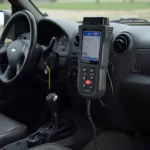The obd2 gas pedal, or more accurately, the accelerator pedal position sensor (APPS), plays a crucial role in your vehicle’s performance and fuel efficiency. It’s a key component that communicates with your car’s computer, telling it how much fuel to inject into the engine based on how far the pedal is depressed. Understanding this connection can be vital for diagnosing performance issues and maintaining optimal fuel economy.
The APPS is a critical part of your vehicle’s electronic throttle control (ETC) system. This system replaces the traditional mechanical linkage between the gas pedal and the throttle body with electronic signals. When you press the gas pedal, the APPS sends a signal to the engine control unit (ECU), which then adjusts the throttle opening accordingly. This allows for precise control over the air and fuel mixture entering the engine, leading to improved performance, fuel economy, and emissions control. A malfunctioning APPS can cause a range of issues, from rough idling and poor acceleration to the dreaded check engine light.
How the OBD2 Scanner Diagnoses Gas Pedal Issues
An OBD2 scanner is an invaluable tool for diagnosing problems with your vehicle, including those related to the obd2 gas pedal and the APPS. By reading the diagnostic trouble codes (DTCs) stored in the ECU, you can pinpoint the source of the issue. For example, a common DTC related to the APPS is P0120, which indicates a problem with the sensor circuit.
Using an OBD2 scanner, you can monitor the APPS voltage in real-time, observing how it changes as you press and release the gas pedal. This allows you to identify issues like a faulty sensor, wiring problems, or a sticking pedal. Some advanced scanners even allow you to perform tests on the APPS, further aiding in diagnosis.
Common Symptoms of a Faulty Gas Pedal Sensor
A few telltale signs can indicate a problem with your gas pedal sensor. These include:
- Hesitation or surging during acceleration
- Sudden drops in engine power
- Rough idling
- Illuminated check engine light
Troubleshooting Gas Pedal Problems with an OBD2 Scanner
Once you suspect a problem with your gas pedal, an OBD2 scanner is your first line of defense. Begin by connecting the scanner and reading any stored DTCs. Then, monitor the APPS voltage readings while operating the gas pedal. If you notice any inconsistencies or unusual readings, this can point to the source of the problem. For instance, a fluctuating voltage reading may indicate a loose connection or a faulty sensor.
Using Live Data to Pinpoint the Issue
Live data from your OBD2 scanner can provide valuable insights into the APPS’s performance. Observe the voltage readings at different pedal positions – idle, partial throttle, and full throttle. Compare these readings to the manufacturer’s specifications to identify any deviations.
96 to 99 mustang torque pro obd2 pids
What is the role of the OBD2 gas pedal in controlling vehicle speed?
The OBD2 gas pedal, through the APPS, communicates the driver’s desired speed to the ECU, which then adjusts the throttle and fuel injection to achieve that speed.
How can I use an OBD2 scanner to check my gas pedal?
Connect the OBD2 scanner, read the DTCs, and then monitor the live data for the APPS voltage.
In conclusion, the obd2 gas pedal and the APPS are essential components for your vehicle’s performance and fuel efficiency. An OBD2 scanner is a crucial tool for diagnosing and troubleshooting any issues related to this system. By understanding the connection between the gas pedal, the APPS, and the ECU, you can maintain your vehicle’s optimal performance and ensure a smooth and efficient driving experience.
2015 cherokee trailhawk check engine code without obd2 scanner
FAQ:
- What does the APPS stand for? Accelerator Pedal Position Sensor
- What is the most common DTC related to the APPS? P0120
- Can I replace the APPS myself? Yes, but it’s recommended to consult a mechanic.
- How often should I check my APPS? Periodically, especially if you notice any driving issues.
- How does a faulty APPS affect fuel economy? It can lead to decreased fuel efficiency.
- Can an OBD2 scanner diagnose all gas pedal issues? Most common issues, yes, but some may require further diagnostics.
- What other components are involved in the ETC system? Throttle body, ECU, and wiring harness.
You might also be interested in articles on our website about “obd2 location gmc 6500” and other related topics.
Need help? Contact us via WhatsApp: +1(641)206-8880, Email: [email protected] or visit us at 789 Elm Street, San Francisco, CA 94102, USA. We offer 24/7 customer support.

